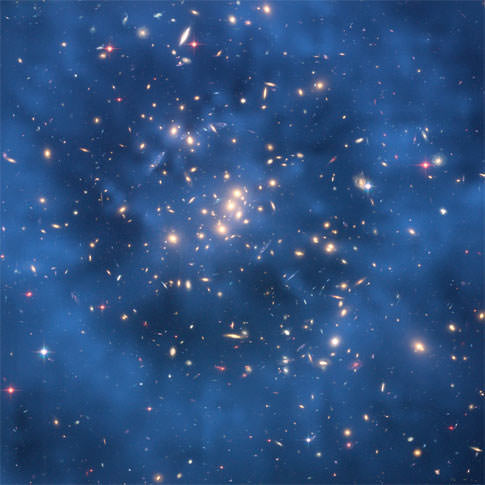Star clusters are interesting inhabitants of the sky. They vary in sizes, distances, and number of stars, but almost all are spectacular to look at. And most of them are in the process of being torn apart. That is certainly the case for the Hyades star cluster – the closest one to Earth at only 153 light years away. The problem is, there is something causing a lot more destruction than would be expected given the mass and energy in the surrounding space. Now, a team of scientists from ESA have a theory as to what the cause of the destruction might be – a mysterious dark matter sub-halo.
This novel theory extends from findings gleaned from data collected by GAIA, ESA’s star mapping satellite. The GAIA team expected to see what are called “tidal tails” trailing and leading the star cluster as it moves throughout the galaxy. These tails are formed when some stars are forced to the outer edges of the cluster, and then pulled by the gravitational pull of the galaxy itself, pushing some stars forward in their journey through the galaxy, while other stars are pulled further behind.
Credit: ESA Youtube Channel
The GAIA team did find tidal tails on either side of the Hyades cluster when they observed it. However, they were extraordinarily long – thousands of light years across the galaxy, each holding thousands of stars. Observing them in their entirety was only possible because of the GAIA data and a computer model that Dr. Tereza Jerabkova, an ESA research fellow, developed with her colleagues.
That model had several added advantages over previous efforts to map the tidal tail of the Hyades. Without the model, thousands of stars that had been left behind by the cluster hundreds of millions of years ago would not be included in the tail due to changes in their orbit during that time. But there was something even more interesting hiding in the data that the model failed to predict.
Credit: ESA YouTube Channel
There seemed to be huge holes in the tidal tail, where stars were completely missing. One of the nice things about well-written simulations is that it is possible to quickly adapt them to new data, and that is exactly what Dr. Jerabkova did. Changing parameters to try to account for the missing stars, she realized that the presence of an object weighing 10 million solar masses could have caused the disruption seen in the tidal tail pattern. Only there wasn’t any object of that size anywhere near the missing stars.
Realizing that they couldn’t see any object, the researchers turned to something that they couldn’t actually see – dark matter. Scientists have long theorized about dark matter sub-halos – invisible clusters of dark matter that exert gravitational forces throughout the galaxy. But so far, no one has ever seen them in action.

Credit: NASA, ESA, M.J. Jee (John Hopkins University)
If the ESA team’s models are correct, a sub-halo could be the cause of the disruption in the Hyades’ tidal tail. While this would be exciting new evidence for the presence of such understudied massive structures, it is far from certain that they are the sole cause of the Hyades’ disruption. As always, more data is needed, and GAIA is still patiently collecting data on more than a billion stars. Maybe the next round of data will hold some additional insight on what exactly is happening to this spectacular star cluster.
Learn More:
ESA – Is the nearest star cluster to the Sun being destroyed?
Astronomy and Astrophysics – The 800 pc long tidal tails of the Hyades star cluster
ScienceNews – The star cluster closest to Earth is in its death throes
LiveScience – A ‘lump’ of dark matter may be ripping apart Taurus’ face
UT – Something other than just gravity is contributing to the shape of dark matter halos
Lead Image:
The Hyades tidal tails
Credit: ESA / GAIA / DPAC
Acknowledgement: S. Jordan / T. Sagrista


The 10 Msolar mass hole punch is similar to the 5 Msolar mass GD-1 star stream hole punch.
“With no giant, bright objects visible zipping away from GD-1, and no evidence for a hidden, second supermassive black hole in our galaxy, the only obvious option left is a big clump of dark matter. That doesn’t mean the object is definitely, 100%, absolutely made of dark matter, Bonaca said.
“It could be that it’s a luminous object that went away somewhere, and it’s hiding somewhere in the galaxy,” she added.
But that seems unlikely, in part due to the sheer scale of the object.
“We know that it’s 10 to 20 parsecs [30 to 65 light-years] across,” she said. “About the size of a globular cluster.””
[ https://www.livescience.com/65483-dark-impactor-could-be-dark-matter.html ]